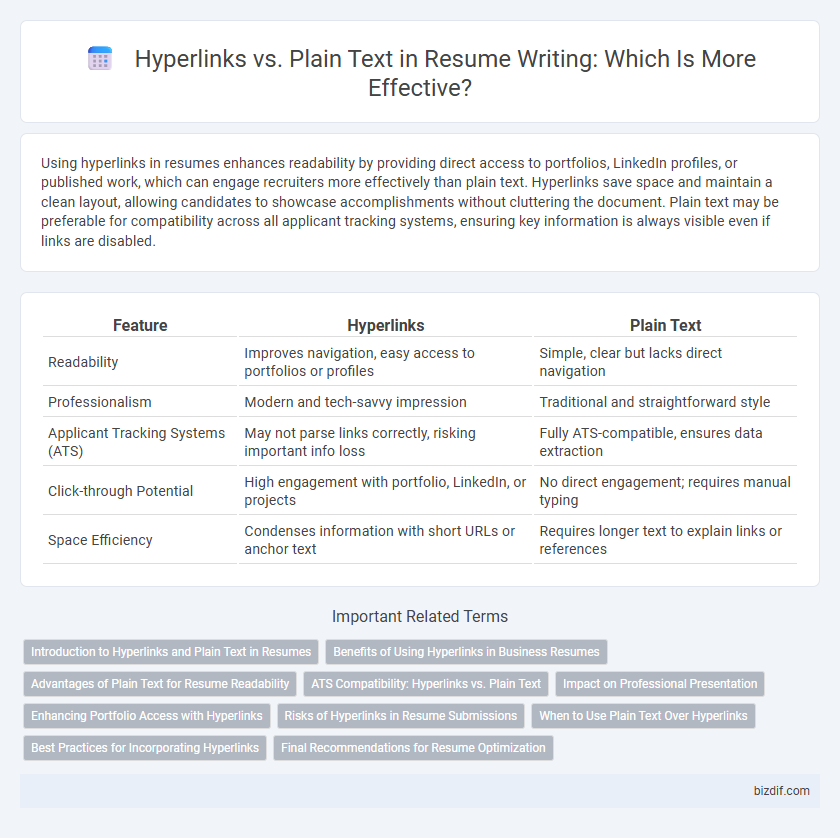Using hyperlinks in resumes enhances readability by providing direct access to portfolios, LinkedIn profiles, or published work, which can engage recruiters more effectively than plain text. Hyperlinks save space and maintain a clean layout, allowing candidates to showcase accomplishments without cluttering the document. Plain text may be preferable for compatibility across all applicant tracking systems, ensuring key information is always visible even if links are disabled.
Table of Comparison
| Feature | Hyperlinks | Plain Text |
|---|---|---|
| Readability | Improves navigation, easy access to portfolios or profiles | Simple, clear but lacks direct navigation |
| Professionalism | Modern and tech-savvy impression | Traditional and straightforward style |
| Applicant Tracking Systems (ATS) | May not parse links correctly, risking important info loss | Fully ATS-compatible, ensures data extraction |
| Click-through Potential | High engagement with portfolio, LinkedIn, or projects | No direct engagement; requires manual typing |
| Space Efficiency | Condenses information with short URLs or anchor text | Requires longer text to explain links or references |
Introduction to Hyperlinks and Plain Text in Resumes
Hyperlinks in resumes enhance interactivity by linking directly to portfolios, professional profiles, or project samples, increasing accessibility and engagement. Plain text, while simpler and universally compatible, may miss opportunities to showcase digital assets or provide quick access to supporting documents. Choosing between hyperlinks and plain text depends on the job industry and the recruiter's preference for digital navigation versus straightforward readability.
Benefits of Using Hyperlinks in Business Resumes
Using hyperlinks in business resumes enhances accessibility by allowing employers to quickly verify credentials and view professional portfolios, which improves candidate credibility. Hyperlinks also save space by linking to detailed information such as project samples or LinkedIn profiles, maintaining a clean and concise resume layout. Incorporating clickable links increases interactivity and engagement, making applications more memorable and technologically savvy.
Advantages of Plain Text for Resume Readability
Plain text resumes enhance readability by ensuring consistent formatting across all devices and applicant tracking systems (ATS), preventing display errors often caused by hyperlinks. They facilitate straightforward parsing by ATS software, increasing the chances of resume content being accurately interpreted and ranked. Avoiding hyperlinks reduces distractions for hiring managers, allowing them to focus on core qualifications without navigating external links.
ATS Compatibility: Hyperlinks vs. Plain Text
ATS Resume scanners often struggle with hyperlinks, sometimes ignoring or misinterpreting linked text which can affect keyword detection and overall parsing accuracy. Plain text URLs ensure that contact information and references remain visible and accessible to ATS software, improving the chances of correct data extraction. Using plain text for links enhances resume compatibility with various ATS systems, boosting the likelihood of progressing through automated screening processes.
Impact on Professional Presentation
Hyperlinks in a resume enhance professional presentation by providing immediate access to portfolios, LinkedIn profiles, or published work, demonstrating digital literacy and ease of verification. Plain text lacks interactivity, potentially limiting engagement and failing to showcase technical proficiency, which may affect the impression on recruiters in digital screening processes. Incorporating well-placed hyperlinks can improve the resume's functionality and modern appeal, aligning with industry standards for professional documentation.
Enhancing Portfolio Access with Hyperlinks
Incorporating hyperlinks in resumes significantly enhances portfolio access by allowing recruiters to instantly view samples of work, projects, or professional profiles with a single click. Hyperlinked text improves the user experience by making navigation seamless and reduces the risk of errors associated with manually typing URLs. Embedding hyperlinks in key sections like contact information or project descriptions ensures that the portfolio is easily accessible and highlights digital proficiency to prospective employers.
Risks of Hyperlinks in Resume Submissions
Hyperlinks in resume submissions can pose security risks as they may lead to malicious websites or trigger spam filters, causing your application to be overlooked. Many applicant tracking systems (ATS) have limited capability to parse hyperlinks correctly, potentially resulting in broken links or missing information. Submitting plain text ensures compatibility across different platforms and reduces the chance of technical issues that could hinder the review process.
When to Use Plain Text Over Hyperlinks
Use plain text in resumes when applying to applicant tracking systems (ATS) that may not accurately parse hyperlinks, ensuring critical information like email addresses and phone numbers remain accessible. Plain text also enhances readability during quick scans by human recruiters who may prefer visible URLs over embedded links. In situations requiring universal compatibility across devices and platforms, plain text guarantees consistent presentation and prevents technical issues associated with broken or non-clickable hyperlinks.
Best Practices for Incorporating Hyperlinks
Incorporating hyperlinks in a resume enhances accessibility and allows recruiters to quickly verify credentials or view portfolios. Best practices include using descriptive anchor text that clearly indicates the link's destination, such as "LinkedIn profile" or "project portfolio," ensuring links are functional and relevant, and avoiding overloading the document with too many hyperlinks to maintain readability. Hyperlinks should be embedded in the text rather than displayed as raw URLs to keep the resume clean and professional.
Final Recommendations for Resume Optimization
For resume optimization, using plain text for contact information and URLs ensures compatibility across all applicant tracking systems (ATS), preventing errors or lost data during parsing. Hyperlinks can be included sparingly for online portfolios or LinkedIn profiles but should be clearly readable as plain text to maintain clarity and accessibility. Prioritize ATS-friendly formatting with straightforward text to maximize resume visibility and effectiveness in recruitment processes.
Hyperlinks vs Plain Text Infographic

 bizdif.com
bizdif.com